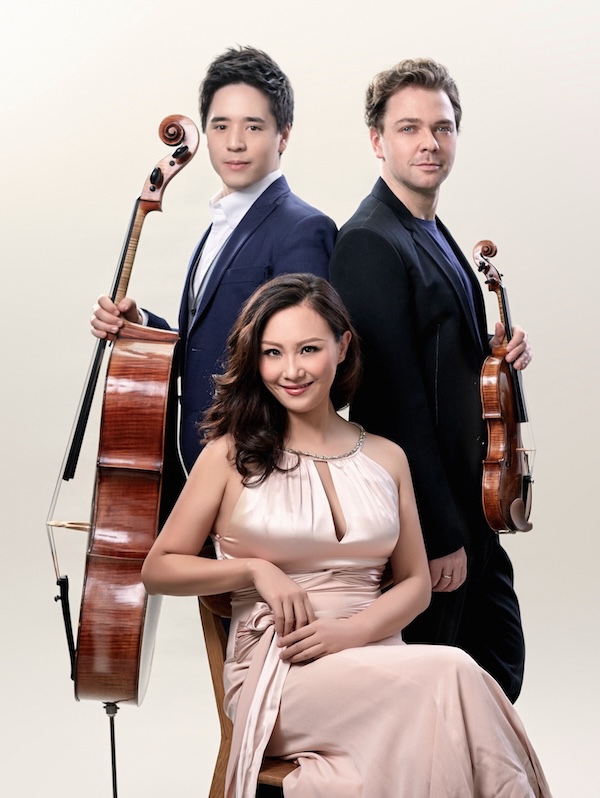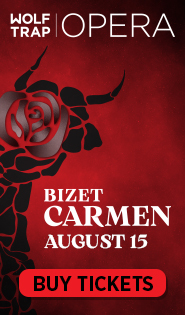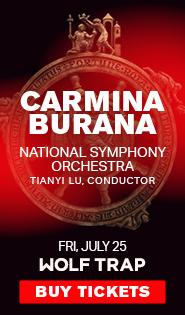Sitkovetsky Trio shows poise, seasoning in Wolf Trap return

The Sitkovetsky Trio performed Sunday at Wolf Trap. Photo; Vincy Ng
When the Sitkovetsky Trio made their Wolf Trap debut in 2019, cellist Isang Enders had been with the group for only about two years. In their return visit in the Barns Sunday afternoon, the musicians sounded more seasoned as an ensemble in a program of music by Sam Perkin, Ravel, and Beethoven.
Violinist Alexander Sitkovetsky and pianist Wu Qian also happen to be husband and wife. During the question and answer session at intermission in 2019, Enders acknowledged that the role of musical third wheel could be difficult. This time around, Enders answered a question about how the group chooses repertoire with a joke about the process involving a lot of fighting. Happily, the disputes apparently happen only behind the scenes.
The group opened with Freakshow, a 2016 suite of seven miniatures by Sam Perkin. The Gŵyl Gregynog Festival commissioned the young Irish composer in 2016, to mark the centenary of the internment of 1,800 Irish men, including Michael Collins, at the Fron-Goch Camp in north Wales. Inspired by the tales of the Rat Circus, in which the prisoners created shows with trapped rats, Perkin added six more movements based on other strange entertainers.
The musical style hewed to the neoclassical in terms of melody and harmony, with some unusual effects added to depict the inspiration of each movement, such as col legno strikes in the third movement (“The Living Skeleton”) and elegant pizzicato and staccato piano in the fourth (“The Gentle Giant”). The longest piece, “Pandora’s Basket,” featured tinkling music-box harmony in the high treble range of the piano, with plucked notes of indeterminate pitch played below the bridge by both string players. The performers gave each of these slender movements individual colors and rhythmic verve, never allowing musical interest to flag.
This movement in the Perkin piece shared some similarities with the piece that followed it on the program, Ravel’s Piano Trio in A Minor, including a mini-quotation, perhaps unintentional, from the Basque dance of Ravel’s first movement. Ravel’s lilting tune, reportedly based on Basque folk songs he heard in Saint-Jean-de-Luz in 1914, is notated in 8/8 meter, creating an irregular combination of duple and triple metric groupings.
This trio struck just the right moderate tempo, not too fast but with stretching rubato. Sitkovetsky played the violin part with expert intonation, more assertive than Enders’ cello part, which was strong on musicality and beauty of tone. Wu Qian added fire to the accelerando section in the first movement. The second movement, a scherzo titled “Pantoum,” felt playful, again at a more relaxed tempo, with Wu Qian gliding serenely in the Trio, where the piano switches to a different meter than the other instruments.
Only in the third movement (“Passacaille”) did the playing become so austere that the sound edged toward dullness. Allusions to the melodic content of the previous two movements passed largely unnoticed as the variations piled up somberly. The final movement more than compensated for this lack of dynamism, with the booming piano voicings from Wu Qian’s hands a particular highlight, flying over the accompaniment of busy trills from her colleagues. Trumpet-like calls near the end signaled that World War I was looming, as Ravel was rushing to finish the piece before he reported for duty as an ambulance driver.
After the usual interview session at intermission, the concert concluded with Beethoven’s Piano Trio No. 7 (“Archduke”), in an interpretation marked by magnificent subtlety and humor. After starting the first movement too hastily, the group settled into a more appropriately moderate tempo by the repeat of the exposition. The recapitulation section proved especially effective, with delicate string pizzicati and sensitive playing from the pianist.
The second movement hit the mark from the opening with a playful pacing of the Scherzo theme. Lugubrious sounds, as if played with furrowed brow, made the Trio section a comic delight, a section singled out by scholar Barry Cooper for “a chromaticism bordering on atonality.” The three musicians all added slight hesitations to their parts at the Scherzo’s return, making that music quite different with just a few minor touches.
The theme and variations of the third movement radiated happiness, again striking an ideal tempo, giving emotional significance through a variety of texture and dynamics rather than slowing down. The final variation only hinted at the minor key tangentially, like bits of cloudiness on an otherwise bright day. The repeated theme of the finale seemed to perk up with each appearance, moving from poky gentility to mercurial unpredictability in the coda.
After this excellent rendition of two of the monuments of the piano trio repertoire, the encore featured a third. The musicians offered an introspective performance of the slow movement from Mendelssohn’s Piano Trio No. 1, a poignant “song without words” in wistful B-flat major to round out an exceptionally strong concert.
Wolf Trap artistic adviser Wu Han joins cellist David Finckel and friends for chamber music by Smetana, Mozart, and Dvořák 7:30 p.m. February 23. wolftrap.org



Posted Feb 12, 2024 at 4:54 pm by Tom
Fair and insightful review of another talented performance in the warmth of the Barns.